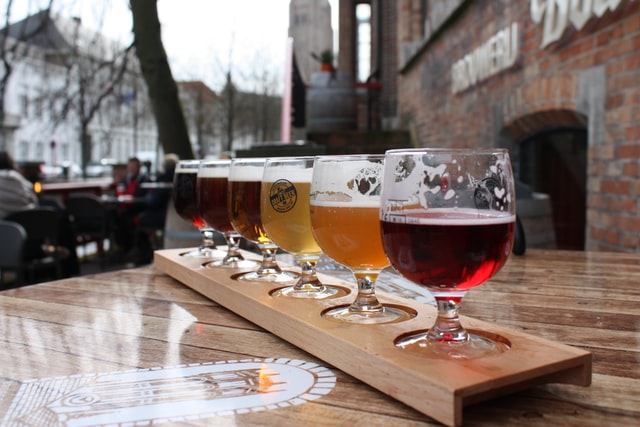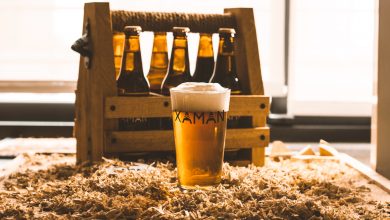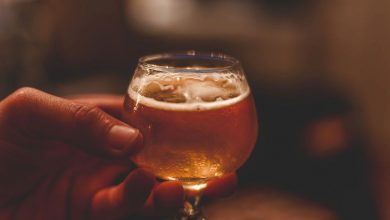Your Comprehensive Guide to Popular Beers of the World

If there’s one thing that we love about beer (besides most things), it’s that depending on which area of the world you’re in, beer has its own unique personality almost every time. This fact contributes to beer drinkers and enthusiasts having beverage tastes and preferences as unique as they are.
We like to celebrate the individuality of beer and think it’s important for our readers to be informed on the various aspects that make the beloved frothy brew unique. Keeping this in mind, for this article, we’d like for you to join us as we take you on a journey exploring 25 different popular and influential beer styles from around the world. We’ll give you key tasting notes on each beer included and throw in some origin facts so you can get to know more about each brew.
Let’s get started!
1. English-Style Bitter
Color: Pale gold or copper
Taste: Malty sweetness, medium bitterness
Aroma: Earthy, fruity
Origin: Originating in England, this bitter-style beer is essentially a pale ale. Bitter beer is sometimes referred to as England’s national drink and originally derived its name from people seeking to identify it separately from milder ales offers.
2. Australian Pale Ale
Color: Light amber
Taste: Caramel sweetness, fruit, malt
Aroma: Citrus
Origin: Drinkers of Australian pale ales enjoy them for the enhanced malty flavor they bring to the table. Pale ales were initially crafted in England but quickly circulated the world, eventually being embraced by Australians for its refreshing qualities.
3. Bohemian-Style Pilsner
Color: Pale straw
Taste: Medium bitterness, biscuit, bread, malt
Aroma: Floral Saaz hops, malt, spice
Origin: Sometimes referred to as the “true pilsner,” Bohemian pilsners were first invented in the Czech Republic in the mid-nineteenth century and have since inspired copycats worldwide. Pilsners are renowned for their balanced bodies, complex flavors, and refreshing finishes.
4. Belgian Golden Strong Ale
Color: Pale gold or copper
Taste: Malty, dry, fruity
Aroma: Hops, apple, pear, orange
Origin: Golden strong ales were first developed in Belgium and modeled after their English counterparts, but with their own unique twists. With the word “strong” in its name, you wouldn’t expect a weak beer. Belgian golden strong ales feature a higher alcohol content around eight percent but disguise their knockout punch with a smooth and refreshing body.
5. West Coast IPA
Color: Medium golden
Taste: Citrus, papaya, pineapple, strong hops
Aroma: Citrus, tropical
Origin: India pale ale (IPA) beers have definitely influenced beer brewing in the U.S.; west coast IPAs are a great example of this. West coast IPAs are beloved for their balanced and bright fruit flavors, tropical aromas, and strong hops influences.
6. German-Style Kolsch
Color: Light straw or pale gold
Taste: Medium bitterness, subtle sweetness
Aroma: Wine, fruit
Origin: For those who like ale and lager, Kolsch might be the best choice. Originating in Cologne, Germany, Kolsch is known to be very refreshing, crisp, and food pairing-friendly.

7. Irish Dry Stout
Color: Dark black
Taste: Medium bitterness, malt, caramel, coffee, barley
Aroma: Hops, malt, roasted barley
Origin: Irish dry stout began making a name for itself in Ireland following the export of English port to the country in the 1700s. Once there, the beer was picked up by a local brewer, Arthur Guinness, where it gained in popularity and eventually featured the strong black characteristics we’re familiar with today.
8. English-Style Old Ale
Color: Dark copper
Taste: Acidic, malt, caramel, toffee, chocolate
Aroma: Malt, nuts, caramel, molasses, dried fruit
Origin: Old ale has a long history in England. This beer was brewed, aged in oak tuns for over a year, and mixed with newly brewed beer to give it its unique flavor profile. Many brewers of old ale today follow the same process.
9. Scottish Ale
Color: Dark chestnut
Taste: Caramel, malt, peat
Aroma: Earthy, smoky, peaty
Origin: Scottish ales are heavily influenced by the brewing styles of English and German beers, but with a Scottish twist true to common local brew styles and climate differences. Drinkers of Scottish ale appreciate the unique smoky and peaty flavors that often shine through.
10. Smoke Beer
Color: Varies
Taste: Varies
Aroma: Varies
Origin: The great thing about smoke beer is it can encompass practically any beer variety. This beer style is becoming increasingly popular worldwide. Usually, it encompasses the beer being processed with smoked malts to gain a unique flavor.
11. American Imperial Porter
Color: Black
Taste: Sweet caramel, cocoa, malt, toffee
Aroma: Burnt
Origin: American imperial porters stem from both English and German heritage here in the U.S. As American hops were used to brew the imperial porter and top-fermenting yeast was used, the American version took on its own unique character.
12. Dunkel
Color: Dark brown
Taste: Bread crust, chocolate, nuts, malt
Aroma: Roasted malt
Origin: Dunkel actually refers to a few different kinds of German lagers that share some common characteristics, such as a refined bitterness and smooth malt flavor.

13. Flanders Red Ale
Color: Reddish-brown
Taste: Tart, plums, cherries
Aroma: Grape
Origin: This type of beer originates from the kingdom of Flanders in Belgium. Flanders red ales are known to be more bitter but are full of complex fruit flavors. Flanders ale is typically aged for two to three years in oak barrels.
14. Fruit Beer
Color: Varies
Taste: Varies
Aroma: Varies
Origin: Much like smoke beer, fruit beer encompasses a wide variety of beer styles that are brewed with various fruit extracts added to derive a unique flavor. While the fruit beer style is brewed all over the world, unsurprisingly, the process originates in Belgium in the 1930s.
15. Belgian Witbier
Color: Pale straw or gold
Taste: Spice, orange peel, coriander
Aroma: Citrus, earthy
Origin: The original of witbiers stretches back hundreds of years in Belgian brewing history with local monasteries. The popularity of witbiers fell off the map or a while but was revived in the mid-1960s.
16. Milk Stout
Color: Black
Taste: Light sweetness, coffee, dark chocolate
Aroma: Malt, chocolate, caramel
Origin: While stout has been around for a long time, the milk stout version didn’t come about until 1875 in England. Interestingly, this beer was originally marketed as nutritious and including milk, which is false.
17. International Dark Lager
Color: Dark amber
Taste: Light fruit, light malt sweetness, spice, herbs
Aroma: Roasted caramel
Origin: The international dark lager style is Mexico’s spin on the popular dark lagers found in Germany. Drinkers of this beer style appreciate its subtle sweetness and refreshing qualities.
18. Saison
Color: Honey
Taste: Hop-forward, malt, fruit, spice
Aroma: Fruit, leather
Origin: Saison is an increasingly popular beer style for American brewers, but it originates in Belgium over 400 years ago. While the beer style lost popularity with brewers for a while, when it was brought back, it gained a following due to its complex and forward fruit and spice flavors.
19. Trappist
Color: Pale straw
Taste: Sweet fruit
Aroma: Fruit
Origin: This unique beer is brewed only by Trappist monks within the Netherlands, Italy, England, Austria, France, Spain, and Belgium. This brew is very carbonated and beloved for its balanced yet complex flavor profile.
20. American Sour Ale
Color: Varies
Taste: Sour, acidic, fruit
Aroma: Caramel, chocolate
Origin: The overall tastes of this beer style can vary as there isn’t a stringent brew process that defines American sour ale. Generally, the sour taste with this beer comes from organic acids that are introduced during the brewing process or naturally derived during the fermentation of the beer.

21. American Wheat Ale
Color: Light amber
Taste: Malt, bread, dough
Aroma: Grain, dough
Origin: The origin of American wheat ale most likely stems from local brewers putting their own spin on Bavarian wheat beers. American wheat ales are well-known to be crisp and refreshing, making them a popular choice for summer.
22. Doppelbock
Color: Deep copper
Taste: Sweet malt, prune, raisin
Aroma: Toasted barley
Origin: German monks are responsible for the original creation of doppelbock. This beer style is revered for its balanced, vibrant, and dense flavors and body.
23. American Amber Lager
Color: Copper or gold
Taste: Hop-forward, malt-forward, spicy, caramel
Aroma: Toasted malt
Origin: The American amber lager brew style is based on the original amber lagers produced in Vienna and for Oktoberfest. This beer style is known to be balanced with complex flavoring.
24. Weizenbock
Color: Dark brown or gold
Taste: Rum, brandy, cocoa, vanilla, nutmeg, plums, raisins, bread, malt
Aroma: Bananas, fruit
Origin: The very carbonated Weizenbock style of beers has been brewed for over 100 years. It is one of the more complex and flavorful of wheat beers Germany has to offer.
25. Gruit Beer
Color: Varies
Taste: Varies, herbal
Aroma: Varies, herbal
Origin: Gruit beers are different in that they don’t use hops in the brewing process. Instead, gruit beer uses a combination of other spices, such as rosemary and chamomile, to obtain the unique taste. Gruit beer has a long history stretching back to medieval Europe when it was made with yeast and cereal grains.



